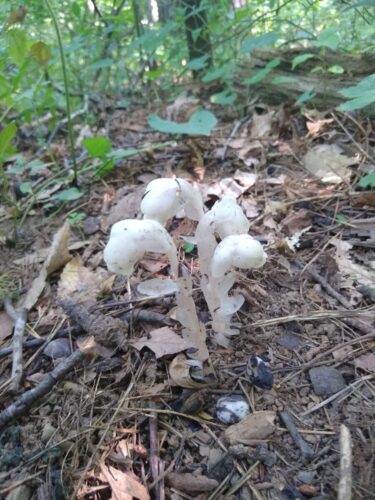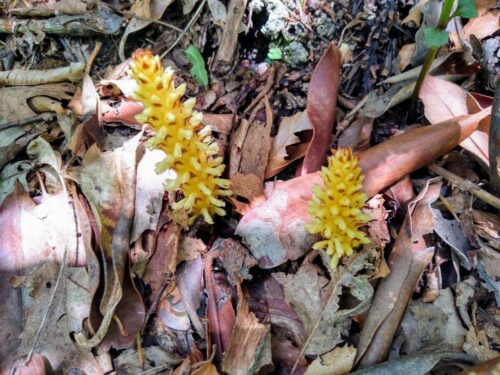Woodland Weirdos
May 7, 2021 9:59 am

By Ellen Powell, DOF Conservation Education Coordinator
There’s a lot going on underfoot in Virginia’s forests, from wild to wonderful to just plain weird. Some of our strangest plants break all the rules we learned back in elementary school. They aren’t green, they don’t photosynthesize, and they don’t even look like plants.

Ghost plant, aka Indian pipes
At first glance, these odd growths emerging from the leaf litter appear to be mushrooms. A closer look reveals they are actually flowering plants, minus the green chlorophyll. They don’t need any, because they don’t make their own food. Known as Indian pipes or ghost plant, Monotropa uniflora is mycoheterotrophic. That’s a fancy way of saying it gets its food from a fungus – specifically, from tiny mycorrhizal fungi that live in nodules on the roots of oak or beech trees. What a lazy way to make a living!
Another freeloading plant of Virginia woodlands is bear corn, Conopholis americana, also known as squawroot or cancer root. Bear corn is truly a parasite, taking its nutrition directly from a host plant, usually an oak or beech tree. And yes, bears do eat it! I’ve read that humans can too, but don’t do so without researching ways to prepare it. Native Americans used this strange plant for a variety of medicinal purposes.

Bear corn, aka squawroot, aka cancer root
Years ago, when I lived in the Northern Neck, I often drove past a wetland with plants covered in what looked like mats and tangles of thin orange wire. An Extension coworker clued me in about this oddball plant. It was dodder, a parasite that he knew as an agricultural field pest. Having no real roots, these vegetative vampires use structures called haustoria to penetrate and suck nutrients and water from their host plants. There are quite a few species of dodder in Virginia, all in the genus Cuscuta. Some are very host-specific, while others are more general in their host selection. Scientists believe that dodder “sniffs out” its preferred host plant by zeroing in on certain chemicals. Check out this short time-lapse video of a tiny dodder vine latching onto a tomato plant!

Dodder (Photo credit: Chris Evans, University of Illinois, bugwood.org)
Want to learn more about these woodland weirdos, or try your skill at identifying them? Consider the Flora of Virginia mobile app, which contains several types of identification keys and lots of technical details about all of Virginia’s plants. Visit https://floraofvirginia.org/ for more information. If you don’t want to buy either the app or the ten-pound book, you can also access a free digital guide to Virginia flora, although this version doesn’t have a key, so you have to know what you’re looking for. Take it from a true nature nerd – you can never have too many reference materials!
Tags: Native Species, Woodland Plants
Category: Education
